Using language notebooks with young learners
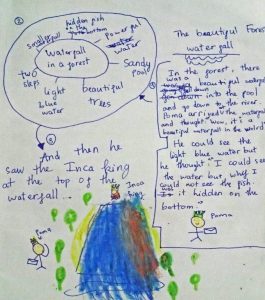 As teachers, we always want our young students to be more effective at recording language. How often do we feel a sense of hopelessness, as we watch our young students mindlessly throw their classwork into the bin at the end of class?
As teachers, we always want our young students to be more effective at recording language. How often do we feel a sense of hopelessness, as we watch our young students mindlessly throw their classwork into the bin at the end of class?
I feel that notebooks are a massive tool in the classroom if used correctly. In my experience, young learners often lack discipline, interest and training in using language notebooks. They lose them, make a mess of them or resort to crude and unhelpful strategies, like writing long lines of single-word vocabulary items which sadly seems to be the go-to homework for many kids in Asian public schools.
With this in mind, I have developed some principles which I believe are most effective when it comes to using and getting the best out of notebooks.
- Personalisation: writing the word scissors 12 times in a line is not personal. Young kids tend to be self-centred, crave attention and like talking about themselves, so making sure the work they do in their notebooks is relevant and personalised is the key.
- Choice: the importance of giving students a choice is something that I have discovered only recently. When you give students a choice they feel a part of the decision-making process and are more willing and motivated to do the work.
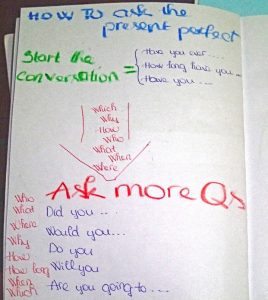
- Creativity: no creative thought goes into copying lists of words and I’ve never heard a child say he/she likes doing it. Allowing children to record language in new ways and to use characters from their course book in story-writing are just two ways to boost creative thought.
- Pictures: young kids love drawing so pictures should be present in the notebooks.
- Sharing: I wondered why kids just throw their classwork in the bin so often. It could be because they don’t think it’s very good or they didn’t enjoy it. Maybe it’s because they know no one else is going to look at it. If students know that they are going to be sharing their notebooks with each other, perhaps this will encourage a higher standard of notebook work.
- Pride: this is linked to sharing. If we can get kids to be proud of and responsible for their notebooks, and to feel like this book is where their best work is done, then they should be much more motivated to produce high quality work.
The set-up
Sometime ago, with the help of colleagues, I gathered some practical ideas as to how to implement these principles and started my young learner notebook experiment. 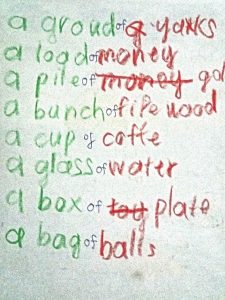 At the time, I was working in a private language school in Vietnam, with classes of a maximum 18 students meeting for a two-hour class twice a week. I introduce
At the time, I was working in a private language school in Vietnam, with classes of a maximum 18 students meeting for a two-hour class twice a week. I introduce
d the notebooks into two classes:
- 7-9 year olds (A2 level)
- 12-14 year olds (A2/B1 level)
The books were very simple: 10 sheets of white A4 paper, folded in half horizontally and then a coloured A4 sheet (chosen by the student) was then used as a cover. I stapled the spine and, voila! Everyone had their own book. Everyone chose their own title for their book and I told them that they could draw whatever they wanted on the front and back cover.
In the first lesson, I showed the students an example of the book they would be making. This instantly got them excited. I then explained what the book would be for: a record for them to write, draw and record language that we studied in class.
This was important: I told the students that this book was their responsibility, that they had to take care  of it and make sure they brought it to class every day. They had to try hard not to lose it and they should only do their best work in it. I also told them that I would sometimes look in their books and write some comments, and that later in the course, I would like them to share their favourite pages from their books with other students from class.
of it and make sure they brought it to class every day. They had to try hard not to lose it and they should only do their best work in it. I also told them that I would sometimes look in their books and write some comments, and that later in the course, I would like them to share their favourite pages from their books with other students from class.
This little chat was crucial. It especially helped the younger class to care and feel responsible for their books. Very rarely did the young students forget their books and they were always motivated to use them when an opportunity knocked.
I should also mention that, initially, my idea was to target the ways students recorded vocabulary only. However, as time passed, with the notebooks in class, I realised they could be used for not only lexis, but fo grammar, creative writing and even autonomous learning.
Reflections and Reccommendations.
- The note books were successful with the younger students
It was great to see young students finally treasure their classwork and many in the younger group enthusiastically took on the new responsibility of adding language to their notebooks. Overall, the older group, especially the boys, did not care as much, however there were still some good notebooks among them.
- More teacher comments
Next time I will take the books in more often, to leave comments and ask questions. Creating private dialogues with students of any age can reveal likes, dislikes, interests and difficulties that we can use to influence lesson planning.
- Used for assessment?
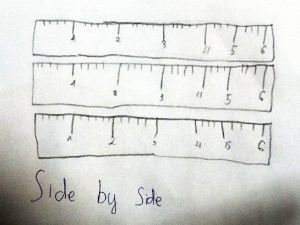
There is potential for these notebooks to contribute to student grades, like a form of coursework.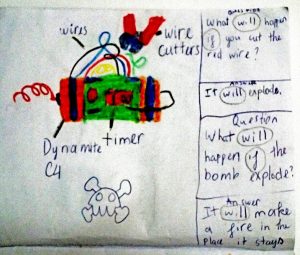
- “Good” writing only
I can’t stress this enough – make sure your students understand that these notebooks are for the best work only. They should use a different notebook for ‘scrap’ work.
- Regular use
Make sure you integrate the notebooks as often as is practically possible. You can save a space after break or at the end of class on a certain day: routine can be good for young learners. Instruct students to take their notebooks out in the middle of class if a nice word or piece of language comes up. Show them how to record this language with a picture and a personal sentence. This acts as good learner training and takes advantage of the numerous language learning moments that emerge in class.
You can see some of the results of the experiment.




